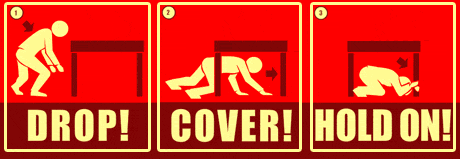Drop, Cover and Hold On in the Great California ShakeOut on October 18, 2012
/
The Southern California (West) area is highly susceptible to earthquakes and earthquake related effects. Numerous earthquake faults crisscross southern California and no one within the area resides more than 10 miles from an active fault. In addition to damage caused directly by groundshaking and related groundfailure, other hazards such as fires can easily start during and shortly after an earthquake.
The driving force of earthquakes in California is movement along the San Andreas Fault and the many associated faults within the San Andreas Fault System that form the tectonic boundary between the Pacific and North American tectonic plates. Along this boundary, the Pacific Plate is moving slowly to the northwest relative to the North American Plate. The Pacific plate underlies most of the Pacific Ocean, as well as all California west of the San Andreas fault. When most people think of earthquakes in California, the San Andreas Fault is usually the first thing to pop in their minds, and while the San Andreas Fault is the longest fault in the state it is by no means the only one to be concerned with. Many other faults are found directly beneath our cities in some of the most densely populated areas.
Because you live in the Southern California (West) area, it is likely that a damaging earthquake will occur and affect you during your lifetime. You decide your fate. You decide your future. The steps you take now can mean the difference between your success or failure after the next big quake.
Start preparing on Thursday, October 18, 2012 at 10:18 a.m. by participating in the Great California ShakeOut drill! Joins millions of other Californians and over 100,000 Ventura County participants who will Drop, Cover and Hold On on that date.
Learn more about the Great ShakeOut at www.shakeout.org. Register for the California ShakeOut at www.shakeout.org/california/register/index.php.

Now, about that Drop, Cover and Hold On drill (more at www.shakeout.org/california/dropcoverholdon)
- DROP to the ground (before the earthquake drops you!)
- Take COVER by getting under a sturdy desk or table, and
- HOLD ON to it until the shaking stops.









